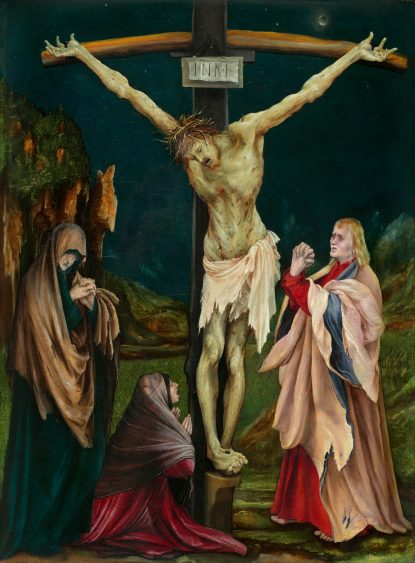
This is a painting by Matthias Grunewald titled “The Small Crucifixion.” Few artists have conveyed the scene of the crucifixion with the intense realism that Grunewald brings to his composition. (CNS photo/Samuel H. Kress Collection via National Gallery of Art)
In his passion, Jesus’ sufferings were unequaled. For the Son of God offered himself as a sacrifice for all. No one, not even the saintliest person, can take on the sins of all people in every time and place. Only God can, and did.
It is this gift of faith, at the heart of our Lenten journeys, that Matthias Grunewald, master German painter, brings to life in a vivid painting titled “The Small Crucifixion.” We are invited to reflect not only on the historical event of the Lord’s crucifixion, but the redemptive meaning of Jesus’ suffering love, poured out for all humanity and for each of us.
Grunewald’s image is particularly poignant in these challenging pandemic days as we walk the via crucis, the path of Jesus’ paschal journey from Good Friday to Easter Sunday.
Grunewald’s best-known masterpiece, the “Isenheim Altarpiece,” was commissioned for the high altar of the church of the Monastery of St. Anthony in Alsace. There, patients suffering from the plague were treated.
In that large altarpiece, Grunewald depicts a crucified Christ whose body is scourged with plague-type sores. Patients bearing the pain of their physical afflictions found spiritual comfort as they gazed on the crucified Jesus and found consolation in the mystery of his suffering.
“The Small Crucifixion” was, most likely, a personal devotional image, intended either for a domestic setting or a private chapel. Here we are drawn into the reality of Jesus’ passion. Color, line, form and composition convey, with remarkable expressive power, the depths of Jesus’ abandonment and the extreme physical suffering of a crucifixion.
[hotblock]
His gaunt body is racked with scars of torture. His emaciated face and bowed head evoke his unbearable agony. Under a piercing crown of thorns, the scarred face of Jesus bleeds. His tattered loincloth gives evidence of the depravity of his tormentors. Few artists have conveyed the scene of the crucifixion with the intense realism that Grunewald brings to his composition.
Jesus’ crucifixion is set in a bare landscape painted in an unusual greenish blue color, evoking the Gospel detail that, at the hour of his passing, the sun darkened and creation itself groaned.
Visitors who stand in front of this painting in its museum setting cannot help but notice that the small panel bends outward into the viewers’ space. Grunewald leaves no room for one to remain a passive bystander or objective onlooker in the face of Jesus’ sufferings.
From the center radiates the Lord’s outstretched arms with twisted hands and contorted feet stretched over the cross. His hands and feet convey the divine anguish over human alienation from God. Obedient even to death on a cross, Jesus’ self-offering rises as a perfect oblation through his gnarled fingers that strain upward to the heavens.
His ankles, twisting beneath the brute force of the nail that pierces his feet, evoke the chains of human alienation. The crossbeam strains downward not only under the mass of his wounded body but from the full weight of divine mercy that takes the form of crucified love.
On either side of the cross are Mary, the mother of Jesus, and the beloved disciple, St. John the Evangelist. Mary’s robed head is bowed with her hands clasped in prayer, as she shares uniquely in her son’s suffering. John conveys the agony of this faithful disciple. Kneeling in anguished meditation at the foot of the cross is St. Mary Magdalene.
Their perspective is meant to be ours as we contemplate Jesus’ passion. Grunewald’s vision allows us to glimpse the relentless mercy of God as it takes the form of suffering love on the cross. We are invited to receive the gift of divine crucified love poured out on the world and on each one of us.
Good Friday is good news in that death no longer has the final word on the human condition. As we enter into the mystery of Jesus’ passion and death on the cross, we are filled with hope in the victorious power of God who will raise him from the dead.
And as we journey from Good Friday to Easter Sunday, Grunewald’s image evokes our vocation to live the new life of the risen Christ.
We know and believe in faith that the horror of Jesus’ crucifixion will most certainly give way to the radiant glory of his, and our own, resurrection. And so we pray, “We adore you, O Christ, and we bless you, because by your holy cross you have redeemed the world.”
***
Jem Sullivan, educator and author, contributes a Scripture column to Catholic News Service and is the author of “Believe, Celebrate, Live, Pray: A Weekly Retreat with the Catechism.”
PREVIOUS: Crowding around Jesus, or standing with him?
NEXT: This Palm Sunday, watch a movie that teaches obedience



Share this story